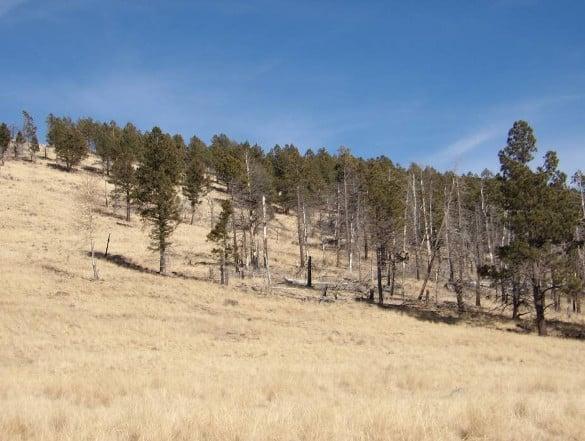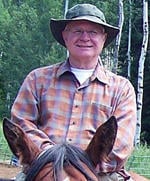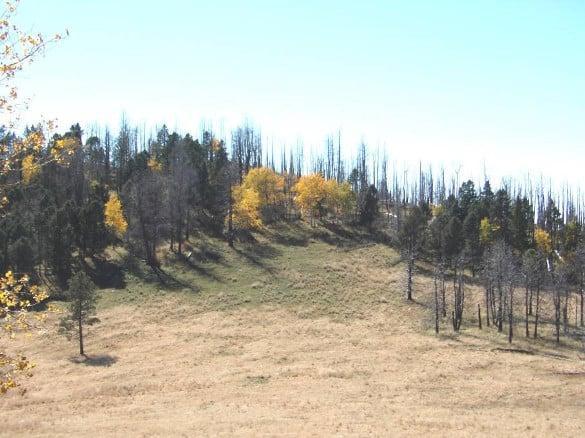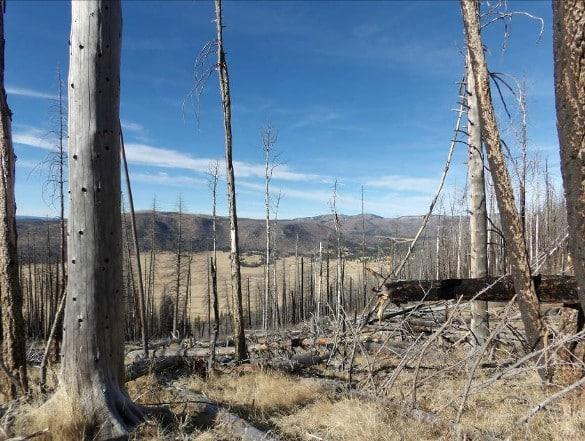 Many trees survived on the eastern flank in the low intensity burn of 2000. There also had been more time for plant growth compared to the burn in 2011. Photo by Robert Dryja
Many trees survived on the eastern flank in the low intensity burn of 2000. There also had been more time for plant growth compared to the burn in 2011. Photo by Robert Dryja
By ROBERT DRYJA
Los Alamos
Scene 1 of the play, “A Hike to the Top” began at the base of Cerro Grande peak where logging and an intense forest fire burn occurred. Scene 2 presented the less fire damaged conifer and aspen forest on the way to the top of Cerro Grande peak. Scene 2 came to a close when the conifer and aspen forest reached the grassy meadowlands. Scene 3, the meadowlands, is well on the way to the top of Cerro Grande peak. The meadowland is high country, reaching 10,200 feet elevation.
A low intensity fire occurred in the meadowlands at the start of the Cerro Grande forest fire. The fire moved down slope and eastward to the conifer forest. However the forest was not very dense at this high elevation and so the fire remained at a low intensity. Low growing shrubs and trees were burnt but the taller and more disbursed conifers growing in or at the edge of the grassy meadowland survived the fire. Grassland and open woodland now exists.
Grassy meadowlands often develop on the southern flank of mountains as the elevation becomes higher. These meadowlands are referred to as rincons. The elevation, daily temperature shifts, moisture level, and direct sun exposure together favor the growth of grasses. The western side of the meadowland shows a similar pattern of grass and disbursed trees, the same as its eastern side. However something different appears when the western slope descends into the Valle Grande. The conifer forest on the slope was burnt in the Las Conchas forest fire of 2011. This was a high intensity fire that burnt all trees, short and tall. A forest of burnt tree trunks now dominates the landscape. The western slope of the Cerro Grande peak represents Scene 4 of the play. The Las Conchas fire is the villain in this play since it results in such a total destruction of life on the western slope.
 The dense conifer forest in the distance was burnt in the high intensity burn of the Las Conchas fire. Aspen are among the first trees to start growing in such a burnt area. Young aspen can be seen growing at the side of the meadow, replacing the burnt conifer forest. Photo by Robert Dryja
The dense conifer forest in the distance was burnt in the high intensity burn of the Las Conchas fire. Aspen are among the first trees to start growing in such a burnt area. Young aspen can be seen growing at the side of the meadow, replacing the burnt conifer forest. Photo by Robert Dryja The Valle Toledo of the Valles Caldera National Preserve can be seen in the distance beyond the burnt trees of the western slope. Photo by Robert Dryja
The Valle Toledo of the Valles Caldera National Preserve can be seen in the distance beyond the burnt trees of the western slope. Photo by Robert Dryja The dead trees resulting from the high intensity Las Conchas fire in 2011 are on the left side of the meadow. Living trees grow on the right side of the meadow. The high intensity Las Conchas fire moved uphill through dense forest. The low intensity Cerro Grande fire moved downhill through a dispersed forest. Photo by Robert Dryja
The dead trees resulting from the high intensity Las Conchas fire in 2011 are on the left side of the meadow. Living trees grow on the right side of the meadow. The high intensity Las Conchas fire moved uphill through dense forest. The low intensity Cerro Grande fire moved downhill through a dispersed forest. Photo by Robert Dryja The western slope of the Cerro Grande once had a dense mixed conifer forest. The lower slope adjacent to the grass land of the Valle Grande still has sections of ponderosa forest that were missed or survived the Las Conchas forest fire. Photo by Robert Dryja
The western slope of the Cerro Grande once had a dense mixed conifer forest. The lower slope adjacent to the grass land of the Valle Grande still has sections of ponderosa forest that were missed or survived the Las Conchas forest fire. Photo by Robert Dryja
